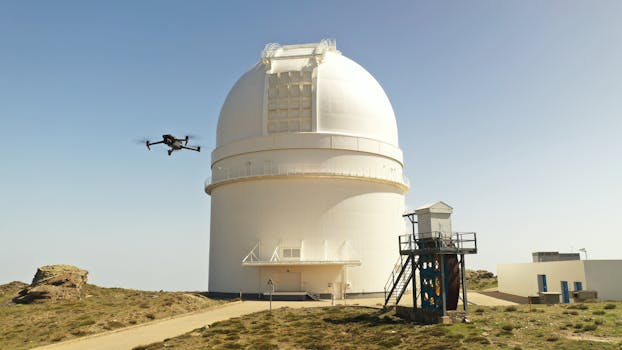Beyond the Atmosphere: The Future of Satellite Technology for Surveillance and Connectivity

Beyond the Atmosphere: The Future of Satellite Technology for Surveillance and Connectivity
The future of satellite technology is rapidly evolving, with advancements in surveillance and connectivity capabilities. Satellite technology has revolutionized the way we communicate, navigate, and monitor our surroundings. With the increasing demand for global connectivity and surveillance, the satellite industry is expected to play a crucial role in shaping the future of our world.
The use of satellite technology for surveillance has become increasingly important in recent years. Satellites are being used for a variety of applications, including military surveillance, environmental monitoring, and disaster response. High-resolution imaging satellites can capture detailed images of the Earth’s surface, allowing for accurate monitoring of troop movements, deforestation, and natural disasters. Additionally, satellite-based sensors can detect and track changes in the environment, such as ocean currents, sea level rise, and weather patterns.
In terms of connectivity, satellite technology is providing internet access to remote and underserved communities around the world. Satellite constellations, such as those being developed by companies like SpaceX and OneWeb, are designed to provide high-speed, low-latency internet connectivity to even the most remote areas of the globe. This technology has the potential to bridge the digital divide, enabling people in remote areas to access information, education, and economic opportunities that were previously out of reach.
The development of new satellite technologies, such as quantum satellites and satellite-based augmented reality, is also on the horizon. Quantum satellites use quantum entanglement to enable secure communication over long distances, while satellite-based augmented reality uses satellite imagery to enhance our experience of the world around us. These innovations have the potential to transform industries such as finance, healthcare, and entertainment, and to enable new forms of artistic expression and creativity.
However, the future of satellite technology is not without its challenges. The increasing number of satellites in orbit around the Earth is raising concerns about space debris and the potential for collisions. Additionally, the use of satellite technology for surveillance and connectivity raises important questions about privacy, security, and regulation. As the satellite industry continues to evolve, it will be important to address these challenges and to develop new technologies and regulations that balance the benefits of satellite technology with the need to protect the environment and human rights.
In conclusion, the future of satellite technology is exciting and rapidly evolving. With advancements in surveillance and connectivity capabilities, satellite technology is poised to play a crucial role in shaping the future of our world. As we look to the future, it will be important to address the challenges associated with satellite technology and to develop new innovations that balance the benefits of this technology with the need to protect the environment and human rights.
The development of satellite technology is a complex and ongoing process, involving the collaboration of governments, industry leaders, and researchers from around the world. As we continue to push the boundaries of what is possible with satellite technology, we can expect to see new and innovative applications of this technology in the years to come. Whether it is used for surveillance, connectivity, or other purposes, satellite technology has the potential to transform our world and to improve the lives of people everywhere.
One of the key drivers of innovation in the satellite industry is the development of new launch technologies. Reusable rockets, such as those being developed by SpaceX and Blue Origin, are reducing the cost of access to space and enabling the launch of more satellites than ever before. This is driving the development of new satellite constellations and enabling the creation of new services and applications that were previously not possible.
Another area of innovation in the satellite industry is the development of new satellite architectures. Traditional satellites are large and complex, requiring significant resources and expertise to design and launch. However, new architectures, such as cubesats and smallsats, are enabling the development of smaller, more agile satellites that can be launched at a lower cost and with greater flexibility. These new architectures are opening up new opportunities for innovation and entrepreneurship in the satellite industry, and are enabling the creation of new services and applications that were previously not possible.
The use of satellite technology for environmental monitoring is also becoming increasingly important. Satellites are being used to track changes in the environment, such as deforestation, ocean pollution, and climate change. This information is being used to inform policy and decision-making, and to develop new strategies for sustainability and conservation. Additionally, satellite technology is being used to monitor and respond to natural disasters, such as hurricanes, wildfires, and earthquakes.
The development of satellite technology is also driving innovation in other fields, such as astronomy and space exploration. Satellites are being used to study the universe and to explore new worlds. The Hubble Space Telescope, for example, has revolutionized our understanding of the universe, and has enabled scientists to study the formation and evolution of galaxies, stars, and planets. Additionally, satellites are being used to explore new worlds, such as Mars and the moons of Jupiter and Saturn.
In terms of the future of satellite technology, there are many exciting developments on the horizon. The development of new launch technologies, such as reusable rockets and space planes, is expected to reduce the cost of access to space and enable the launch of more satellites than ever before. Additionally, the development of new satellite architectures, such as cubesats and smallsats, is expected to enable the creation of new services and applications that were previously not possible.
The use of satellite technology for connectivity is also expected to continue to grow, with the development of new satellite constellations and the expansion of existing ones. This will enable the provision of high-speed, low-latency internet connectivity to even the most remote areas of the globe, and will have a major impact on the way we communicate, work, and live.
In conclusion, the future of satellite technology is exciting and rapidly evolving. With advancements in surveillance and connectivity capabilities, satellite technology is poised to play a crucial role in shaping the future of our world. As we look to the future, it will be important to address the challenges associated with satellite technology and to develop new innovations that balance the benefits of this technology with the need to protect the environment and human rights.
See more:






